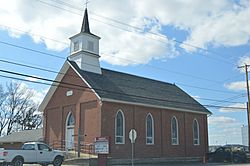Lilly Chapel, Ohio facts for kids
Quick facts for kids
Lilly Chapel, Ohio
|
|
|---|---|

Trinity United Methodist Church
|
|
| Country | United States |
| State | Ohio |
| Counties | Madison |
| Elevation | 974 ft (297 m) |
| Time zone | UTC-5 (Eastern (EST)) |
| • Summer (DST) | UTC-4 (EDT) |
| ZIP code |
43162
|
| Area code(s) | 614 |
| GNIS feature ID | 1064995 |
Lilly Chapel is a small, unincorporated community located in Madison County, Ohio, United States. An "unincorporated community" means it's a group of homes and businesses that isn't officially a town or city with its own local government. It's found in Fairfield Township, about three miles west of Georgesville.
Contents
History of Lilly Chapel
How the Community Began
The story of Lilly Chapel began in 1850. A Methodist church was built on land given by a man named Wesley Lilly. Because of his generous gift, the church was named "Lilly Chapel." At first, there wasn't a town around the church, but many settlers from the area came to worship there.
In 1871, exciting news arrived: a Short-line railroad was planned to run between Columbus and Springfield. People expected the railroad to bring growth, so a store opened near the church. By 1873, the railroad was finished, and a train station was built. It was also named Lilly Chapel.
Founding the Town and Getting a Post Office
The community itself was officially started on August 28, 1871. It was laid out by Henry Gilroy and Henry Lilly. They first called the new settlement "Gilroy." However, since the church and the train station were already known as Lilly Chapel, Henry Lilly decided to use that name when he asked for a post office.
The Lilly Chapel Post Office opened on April 16, 1873. The first postmaster, Thomas Horn, was also the community's first railroad agent. This shows how important the railroad was to the town's early days.
Growth and Businesses
Lilly Chapel continued to grow. In 1880, Dr. Taggart became the town's first doctor. By 1885, the community had several important businesses. These included three general stores, a grocery store, and two blacksmith shops. There was also a shop for making wagons and buggies.
The town also had two steam sawmills and two grain elevators, which were important for farming. In 1878, a factory that made steam-powered tiles was built. By 1915, Lilly Chapel had a bank, two churches, and a high school. It also had two general stores, a hardware store, a candy shop, a grain elevator, and a blacksmith. The post office eventually closed on December 31, 1957. Today, mail service for Lilly Chapel comes from the West Jefferson branch.
Population Over Time
Lilly Chapel has always been a smaller community. In 1885, about 200 people lived there. By 1915, the population had grown to 370 residents.


